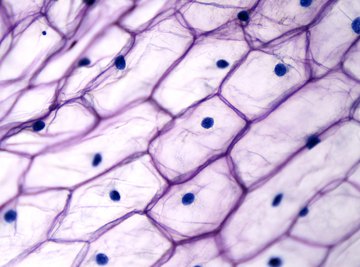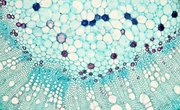
The plasma membrane, also called the cell membrane or phospholipid bilayer, is the sack that surrounds cells. Homeostasis is a state of balanced equilibrium, where everything is running smoothly. The plasma membrane maintains homeostasis in the cell by keeping cell contents in and foreign material out, and by providing controlled avenues for the transportation of fuel, fluids and waste.
TL;DR (Too Long; Didn't Read)
Cells in homeostasis are successfully maintaining the internal conditions necessary for basic functioning. The plasma membrane is essential for maintaining these conditions by separating the inside of the cell from everything else. Plasma membranes are made up of a phospholipid bilayer, which is a chain of fatty acids attached to a phosphate group. The fatty acids form the interior layer of the plasma membrane, and are hydrophobic, which means they repel water. The phosphate groups form the exterior layer of the plasma membrane, and are in contact with water.
The cell needs to export waste and other molecules, and import fuels and fluids. Plasma membranes allow water, oxygen and carbon dioxide to pass through by osmosis, or passive diffusion. For other types of molecules that need to cross the plasma membrane, cells use transport systems. Pumps push molecules against a concentration gradient. Channels open a gate for molecules to flow with their concentration gradient. Transporters bond to specific types of molecules and carry them through the membrane.
Same State
"Homeostasis" means "same state." Cells in homeostasis are successfully maintaining the internal conditions necessary for basic functioning. The plasma membrane is absolutely essential for maintaining these conditions. Simply put, the plasma membrane separates the inside of the cell from everything else. Without it, a cell is nothing more than a popped balloon, spilling its contents out into space.
Hydrophobic, Hydrophilic
Plasma membranes are made up of a phospholipid bilayer. Phospholipids are chains of fatty acids attached to a phosphate group. "Bilayer" means two connected layers. When phospholipids get together, they naturally form a double layer, with their phosphate groups facing out and their fatty tails pointing toward one another. The fatty interior of this layer is called "hydrophobic" because it repels water. The surrounding phosphates are called "hydrophilic" because they come into contact with fluid inside and outside the cell. The plasma membrane separates these two sets of fluids and their contents.
Passive Transport
Keeping the cell’s inside and separate from the world is not enough for homeostasis, however. A completely isolated cell soon runs out of fuel and fluid and drowns in its own waste. The plasma membrane also maintains homeostasis by making sure materials can move in or out as necessary. Homeostasis depends on maintaining correct fluid levels within the cell and on exchanging useable materials, such as oxygen, for waste products, such as carbon dioxide.
Plasma membranes allow water, oxygen and carbon dioxide to pass through by osmosis, or passive diffusion. Passive diffusion is the process in which molecules travel through a semipermeable barrier along a concentration gradient - that is, from an area of greater concentration to one of lower concentration.
Active Transport
Only a small number of materials can pass through the plasma membrane by passive diffusion; if it were open to everything, it would not be a barrier. Yet cells need to control the movement of a variety of other molecules in and out of their membranes to maintain homeostasis. To do this, cells have devised a variety of transport systems that use proteins embedded in the lipid bilayer as gates for cells to open and close.
There are three major types of transport systems in the plasma membrane: pumps, channels and transporters. Pumps use energy produced by the cell to move molecules against a concentration gradient. Channels open a gate for molecules to flow with their concentration gradient. Transporters bond to specific types of molecules and carry them through the membrane.
References
About the Author
Angela Libal began writing professionally in 2005. She has published several books, specializing in zoology and animal husbandry. Libal holds a degree in behavioral science: animal science from Moorpark College, a Bachelor of Arts from Sarah Lawrence College and is a graduate student in cryptozoology.
